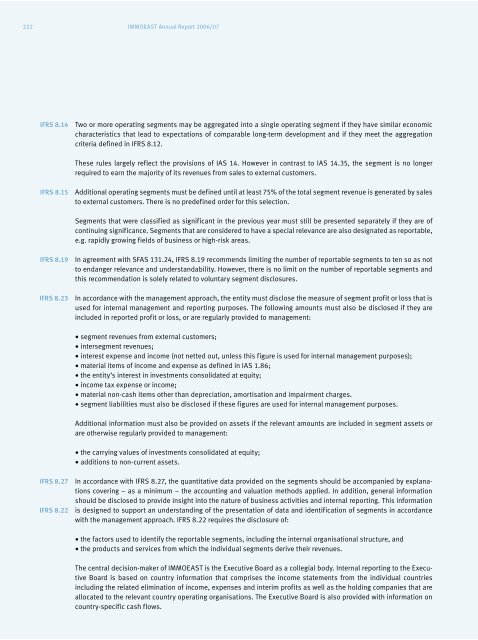IMMOEAST Annual Report 2006/07
IMMOEAST Annual Report 2006/07
IMMOEAST Annual Report 2006/07
Create successful ePaper yourself
Turn your PDF publications into a flip-book with our unique Google optimized e-Paper software.
222 <strong>IMMOEAST</strong> <strong>Annual</strong> <strong>Report</strong> <strong>2006</strong>/<strong>07</strong><br />
IFRS 8.14<br />
IFRS 8.15<br />
IFRS 8.19<br />
IFRS 8.23<br />
IFRS 8.27<br />
IFRS 8.22<br />
Two or more operating segments may be aggregated into a single operating segment if they have similar economic<br />
characteristics that lead to expectations of comparable long-term development and if they meet the aggregation<br />
criteria defined in IFRS 8.12.<br />
These rules largely reflect the provisions of IAS 14. However in contrast to IAS 14.35, the segment is no longer<br />
required to earn the majority of its revenues from sales to external customers.<br />
Additional operating segments must be defined until at least 75% of the total segment revenue is generated by sales<br />
to external customers. There is no predefined order for this selection.<br />
Segments that were classified as significant in the previous year must still be presented separately if they are of<br />
continuing significance. Segments that are considered to have a special relevance are also designated as reportable,<br />
e.g. rapidly growing fields of business or high-risk areas.<br />
In agreement with SFAS 131.24, IFRS 8.19 recommends limiting the number of reportable segments to ten so as not<br />
to endanger relevance and understandability. However, there is no limit on the number of reportable segments and<br />
this recommendation is solely related to voluntary segment disclosures.<br />
In accordance with the management approach, the entity must disclose the measure of segment profit or loss that is<br />
used for internal management and reporting purposes. The following amounts must also be disclosed if they are<br />
included in reported profit or loss, or are regularly provided to management:<br />
• segment revenues from external customers;<br />
• intersegment revenues;<br />
• interest expense and income (not netted out, unless this figure is used for internal management purposes);<br />
• material items of income and expense as defined in IAS 1.86;<br />
• the entity’s interest in investments consolidated at equity;<br />
• income tax expense or income;<br />
• material non-cash items other than depreciation, amortisation and impairment charges.<br />
• segment liabilities must also be disclosed if these figures are used for internal management purposes.<br />
Additional information must also be provided on assets if the relevant amounts are included in segment assets or<br />
are otherwise regularly provided to management:<br />
• the carrying values of investments consolidated at equity;<br />
• additions to non-current assets.<br />
In accordance with IFRS 8.27, the quantitative data provided on the segments should be accompanied by explanations<br />
covering – as a minimum – the accounting and valuation methods applied. In addition, general information<br />
should be disclosed to provide insight into the nature of business activities and internal reporting. This information<br />
is designed to support an understanding of the presentation of data and identification of segments in accordance<br />
with the management approach. IFRS 8.22 requires the disclosure of:<br />
• the factors used to identify the reportable segments, including the internal organisational structure, and<br />
• the products and services from which the individual segments derive their revenues.<br />
The central decision-maker of <strong>IMMOEAST</strong> is the Executive Board as a collegial body. Internal reporting to the Executive<br />
Board is based on country information that comprises the income statements from the individual countries<br />
including the related elimination of income, expenses and interim profits as well as the holding companies that are<br />
allocated to the relevant country operating organisations. The Executive Board is also provided with information on<br />
country-specific cash flows.


